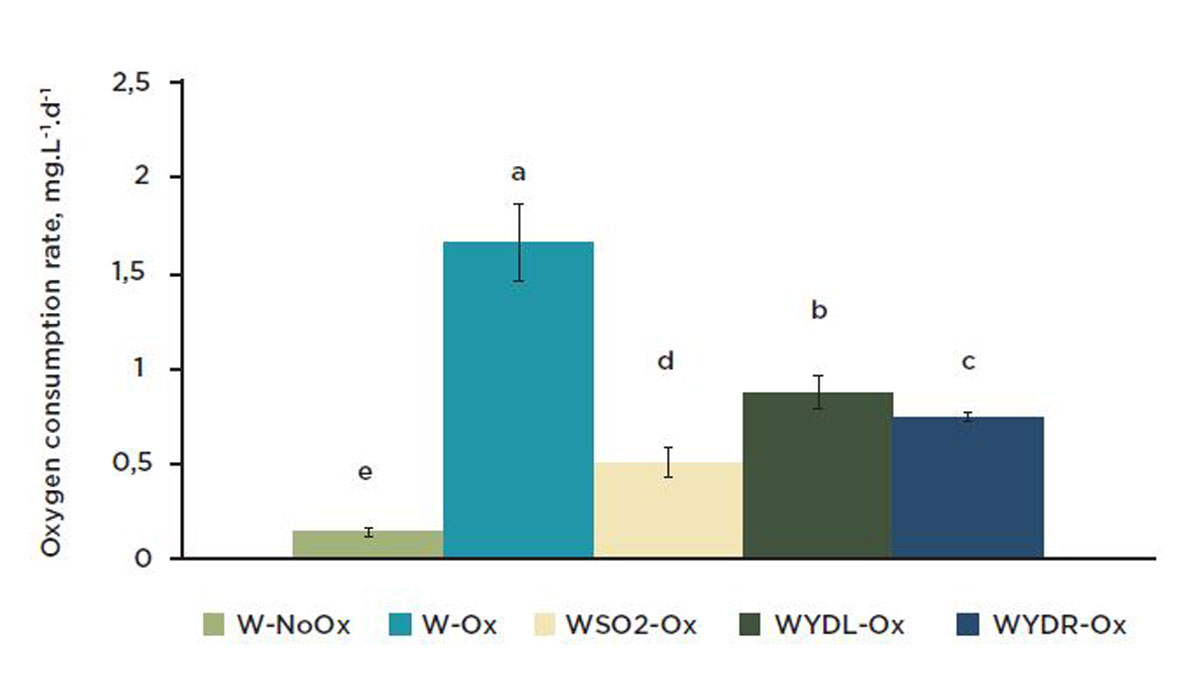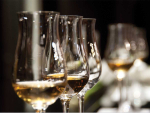Next Generation Viticulture: Capture more light to harvest more grapes
Transforming canopy management systems to maximise sunlight could increase vineyard profitability without compromising wine quality, says researchers.
A promising alternative for white wine oxidation prevention.
Abstract
In the previous decade, the use of Yeast Derivatives (YD) was proposed as a new strategy to control wine oxidation (Comuzzo et al., 2015). These products are obtained from yeasts by autolytic or hydrolytic processes and then dried to obtain the commercial products. The aim of this work was to carry out a preliminary investigation of commercial YDs with different compositions in order to (i) compare their capacity to prevent white wine oxidation in comparison with conventional treatment using SO2, and (ii) evaluate their impact on wine quality.
Introduction
Oxidation processes constitute a major challenge in winemaking, because they can result in browning, varietal aroma loss and the emergence of oxidation off-odours (like brown apple, nutty and curry odours), thus reducing wine quality. Despite the mechanisms involved in wine oxidation having been extensively researched1, finding a way to protect wine against oxidative spoilage remains one of the main goals of oenology. Moreover, the oxidation of young white wines occurs faster when low levels of SO2 are used. In the context of competitive global winemaking marketing strategies, it has become crucial to reduce or even eliminate the use of SO2 and to find alternative antioxidant and/or antimicrobial agents. For this reason, the aim of this work was to carry out a preliminary investigation into the antioxidant activity of YDs in white wine. Two different YDs were added to white wine and their ability to prevent wine oxidation in oxidative conditions was compared to that of conventional SO2 addition. Analyses of oxygen consumption rates, colour, acetaldehyde and sensory analyses of the treated wine were carried out and discussed.
Experimental Design
Two different commercial yeast derivatives (YD, Laffort, France) were tested: one naturally rich in lipids (YDL) and the other naturally rich in reducing compounds, including glutathione (YDR). The wine for the experiments was a Chardonnay (PGI Pays D’Oc) from the 2019 vintage. The values for the classical oenological parameters of the wine were: alcoholic degree = 12.7 vol %, pH = 3.4, total acidity = 6.11 g/L of tartaric acid, volatile acidity = 0.7 g/L of acetic acid (OenoFoss™, Foss analytical, Denmark). Total and free SO2 were 3.2 ± 0.7 and 1.1 ± 0.2 mg/L respectively (Y15 analyser, Biosystems S.A., Barcelona). The different treatments were: wine before oxygenation at saturation (W-NoOx); wine saturated with oxygen (O2 = 8 ± 0.7 mg/L, W-Ox); Wine + YDR at 0.3 g/L and saturated with O2 ( WYDR-Ox); Wine + YDL at 0.3 g/L (W-YDL-Ox); and Wine + SO2 (WSO2-Ox) with total SO2 at 35 ± 5 mg/L and free SO2 at 15 ± 3 mg/L. 320 mL of each treated wine was put into 250 mL glass bottles (in triplicate), filled to the brim and saturated with O2. The dissolved oxygen measurements were performed on-line with the luminescence sensor (Pyroscience optical O2 sensor, Bioneuf, France) at 1h intervals until total O2 consumption had been reached (after about 15 days). Using this data, the Oxygen Consumption Rate (OCR, expressed as mg/L of O2 consumed per day) was calculated. OCR represents oxygen consumption at a constant rate for 4-6 days. Subsequently, the rate of consumption decreases until it reaches a plateau, which is not considered in the OCR evaluation. Base chemical parameters (Table 1) were determined by FT-IR spectroscopy with OenoFoss™. Total and free SO2 were determined using a Biosystems enzymatic kit with a Y15 analyser (Biosystems S.A., Barcelona). The chromatic characteristics of the wine samples were determined using the CIELab universal colour system. Acetaldehyde in wines was determined by gas chromatography with flame ionisation detection (GF-FID). All experiments and analysis were carried out in triplicate. Finally, in the sensory analysis, 19 judges assessed the intensity of the oxidation offodour (0 = absent, 10 = very high) of each treated wine.
Oxygen Consumption Rate of the Experimental Wines
Figure 1 shows the OCR of the experimental wines. For the air-saturated wines, the oxygen consumption rate was in the following order (from highest to lowest OCR): W-Ox > WYDL-Ox > WYDR-Ox > WSO2-Ox > W-NoOx. The oxygen consumption rate of W-NoOx was very low (0.1 mg/L per day), because the initial O2 concentration was < to 1 mg/L.
 |
|---|
|
Figure 1. Oxygen consumption rate of the experimental wines. All data are expressed as the average of 3 replicates ± standard deviation. Different letters indicate a significant different (p<0.05). |
In this case, the OCR can be considered negligible. Compared to levels in W-Ox, O2 consumption was 2.5 times lower in the wine treated with SO2, and approximately 2 times lower in the wine treated with YDR and YDL. These results show that the addition of both YDs reduced the oxygen consumption kinetics in wine to levels almost comparable to the addition of a conventional dose of SO2. The YDs may cause slower oxygen consumption in the white wine by scavenging oxidative radicals that would otherwise accelerate oxidation processes in conditions of low sulfur dioxide in wine (in our case < 5 mg/L).
| Ethanol % (v/v) | pH | Lactic Acid (g.L-1) | Volatile Acidity (acetic acid g.L-1) | Total Acidity (tartaric acid g.l-1) | Free (SO2 mg.L-1) | Total SO2 (mg.L-1) | |
| W-noOx |
12.70± 0.02b |
3.44± 0.004 a |
4.10± 0.15a |
0.76± 0.01 ab |
6.11 ± 0.11 a |
1.00 ± 0.62 b |
3.40 ± 0.55 b |
| W-Ox |
12.92 ± 0.01 a |
3.41 ± 0.002 a |
4.20 ± 0.16 a |
0.73 ± 0.02 a |
6.10 ± 0.10 a |
1.00 ± 0.55 b |
3.50 ± 0.45 b |
| WSO2-Ox |
12.91 ± 0.01 a |
3.41 ± 0.004 a |
3.80 ± 0.15 b |
0.76 ± 0.02 ab |
6.12 ± 0.12 a |
5.00 ± 0.68 a |
34.20 ± 2.10 a |
| WYDR-Ox |
12.95 ± 0.02a |
3.42 ± 0.003 a |
4.20 ± 0.16 a |
0.78 ± 0.02 b |
6.13 ± 0.10 a |
1.50 ± 0.50 b |
3.50 ± 0.65 b |
| WYDL-Ox |
12.90 ± 0.02 a |
3.41 ± 0.004 a |
4.20 ± 0.17 a |
0.76 ± 0.01 ab |
6.09 ± 0.12 a |
1.00 ± 0.65 b |
3.50 ± 0.50 b |
Effects of Treatments on Base Chemical Parameters and Wine Colour
Values for the classical oenological parameters of the experimental wines were determined (Table 1). As expected, in the wine treated with sulfur dioxide, free SO2 decreased after oxidation; i.e., from 15 mg/L to 5 mg/L (Table 1).
Because oxidation phenomena can cause wine browning, the chromatic characteristics of the wine were measured by CIELab. Table 2 shows the L*, a*, b* values of treated wines compared with the control wine (W-NoOx). As expected, the presence of SO2 in the wine inhibited oxidation and thus preserved the colour. The addition of YDR and YDL showed a good efficacy for all a*, b* and L* parameters, whose values were similar to those of the wine with added SO2 (WSO2- Ox) and significantly different to W-Ox (Table 2). These results are promising in terms of the potential use of both the studied YDs as alternative treatments to using SO2 for preventing white wine from browning.
Impact of Treatment on Oxidation Off-Odours
Besides the oxidation markers, acetaldehyde is the principal compound to be derived from the chemical oxidation of wine. Figure 2A shows that after oxygenation the acetaldehyde content is higher than in W-NoOx, indicating its formation after wine oxidation. The sulfited wine (WSO2-Ox) contained the same amount of acetaldehyde as that in the wine not exposed to oxygen (W-NoOx). Interestingly, both YDs reduced acetaldehyde accumulation in the wine after O2 exposure, and this was particularly the case for the YD rich in reducing compounds (YDR).
In order to determine the ability of YDs to prevent the occurrence of oxidation off-odour following oxygen exposure, the experimental wines were also submitted to a sensory analysis (Figure 2B). The sensory panel were asked to evaluate the intensity of oxidation off-odour; i.e., nutty, brown apple odour. The results of the sensory analysis showed the W-Ox wine to be the most oxidised from a sensory point of view. The wines containing added antioxidants (SO2 or YDs) obtained a lower score for oxidation off-odour intensity. The results of the sensory analysis are consistent with those obtained by acetaldehyde analysis, indicating that the YDs could perform as well as SO2 in preventing the occurrence of oxidation off-odours.
Conclusions
This study has shown for the first time that, the addition of YDs to white wine instead of SO2 protects the wine from browning and limits the accumulation of acetaldehyde. YDL and YDR showed interesting antioxidant properties, which could be exploited in low- or no-added sulfite winemaking. Additional studies are underway to better understand the influence of YD composition on their antioxidant activity in wine.
References
1Univ. Bordeaux, INRAE, Bordeaux INP, Bordeaux Sciences Agro, UMR 1366 OENOLOGIE, ISVV, F-33140 Villenave d’Ornon, France
2Amarante Process, ADERA, 33600 PESSAC, France
3Università degli Studi di Napoli Federico II, 83100 Avellino, Italia
4BioLaffort, Bordeaux, France
Article from “Antioxidant activity of yeast derivatives: Evaluation of their application to enhance the oxidative stability of white wine”, https://doi.org/10.1016/j.lwt.2022.114116
1Danilewicz, J.C. 2003. Review of reaction mechanisms of oxygen and proposed intermediate reduction products in wine: Central role of iron and copper. Am. J. Enol. Vitic. 54:73-85.
2C. Nioi, M.T. Lisanti, F. Meunier, P. Redon, A. Massot, Virginie Moine. Antioxidant activity of yeast derivatives: Evaluation of their application to enhance the oxidative stability of white wine. LWT, 171 (2022). https://doi.org/10.1016/j.lwt.2022.114116.
3Waterhouse, A.L. and Laurie, V.F. (2006) Oxidation of Wine Phenolics: A Critical Evaluation and Hypotheses. American Journal of Enology and Viticulture, 57, 306-313. DOI: 10.5344/ajev.2006.57.3.306

Over the past three years or so, the New Zealand Winegrowers Board has consulted with members on proposals to reform…

OPINION: New Zealand is the "last great bastion standing" when it comes to wine imports to the United States, wine-business…
The large 2025 harvest will exacerbate the wine industry's "lingering" supply from recent vintages, New Zealand Winegrowers Chief Executive Philip…
If you find a new consumer in a developed wine market, you are taking them from someone else, says Blank…
With the stars of Matariki to rise in June, Jeff Sinnott, a member of the Tuku Māori Winemakers Collective, looks at…